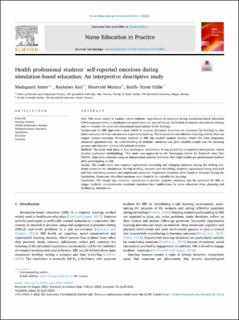| dc.contributor.author | Madsgaard, Anine | |
| dc.contributor.author | Røykenes, Kari | |
| dc.contributor.author | Østervold, Monica J | |
| dc.contributor.author | Smith-Strøm, Hilde | |
| dc.date.accessioned | 2023-03-07T09:37:10Z | |
| dc.date.available | 2023-03-07T09:37:10Z | |
| dc.date.created | 2022-08-17T14:29:46Z | |
| dc.date.issued | 2022 | |
| dc.identifier.citation | Nurse Education in Practice. 2022, 63, Article: 103353, 1-7 | en_US |
| dc.identifier.issn | 1471-5953 | |
| dc.identifier.uri | https://hdl.handle.net/11250/3056342 | |
| dc.description | This is an open access article under the CC BY license (http://creativecommons.org/licenses/by/4.0/) | en_US |
| dc.description.abstract | Aim: This study aimed to explore active students’ experiences of emotions during simulation-based education (SBE) sequences when a simulation was performed as a part of formal curriculum in natural educational settings and to consider the practical educational implications of the findings.
Background: An SBE approach is used widely in nursing education. Emotions are necessary for learning to take place and some of these can prevent or promote learning. This is an active and affective learning activity that can trigger various emotions. Previous research in SBE has studied student anxiety, which has been frequently measured quantitatively. An understanding of students’ emotions can give valuable insight into the learning process and improve nursing educational practice.
Methods: The study took place in four Norwegian universities. It was guided by interpretive descriptions, which involve qualitative methodology. This study was approved by the Norwegian Centre for Research Data (No: 59059). Data were collected using an interpersonal process interview with eight healthcare professional students after participating in SBE.
Results: The results show that students experienced coexisting and changing emotions during the shifting academic scenes in the simulations. During briefing, scenario and debriefing, students experienced being activated and had coexisting pleasant and unpleasant emotions. Unpleasant emotions were found to decrease during the simulation. Numerous identified emotions were found to be valuable for learning.
Conclusion: The insight into students’ experience of arousal, negative emotions and the potential for SBE to trigger students’ comprehensive academic emotions have implications for nurse educators when planning and facilitating simulations. | en_US |
| dc.language.iso | eng | en_US |
| dc.publisher | Elsevier | en_US |
| dc.rights | Navngivelse 4.0 Internasjonal | * |
| dc.rights.uri | http://creativecommons.org/licenses/by/4.0/deed.no | * |
| dc.subject | learning | en_US |
| dc.subject | emotions | en_US |
| dc.subject | qualitative | en_US |
| dc.subject | simulation-based education | en_US |
| dc.subject | health professional students | en_US |
| dc.subject | nursing students | en_US |
| dc.title | Health professional students’ self-reported emotions during simulation-based education: An interpretive descriptive study | en_US |
| dc.type | Peer reviewed | en_US |
| dc.type | Journal article | en_US |
| dc.description.version | publishedVersion | en_US |
| dc.rights.holder | © 2022 The Author(s). Published by Elsevier Ltd. | en_US |
| dc.source.pagenumber | 1-7 | en_US |
| dc.source.volume | 63 | en_US |
| dc.source.journal | Nurse Education in Practice | en_US |
| dc.identifier.doi | 10.1016/j.nepr.2022.103353 | |
| dc.identifier.cristin | 2043874 | |
| dc.source.articlenumber | 103353 | en_US |
| cristin.ispublished | true | |
| cristin.fulltext | original | |
| cristin.qualitycode | 1 | |

